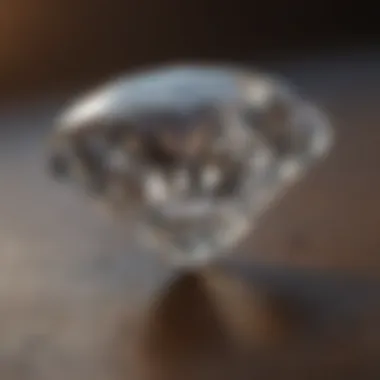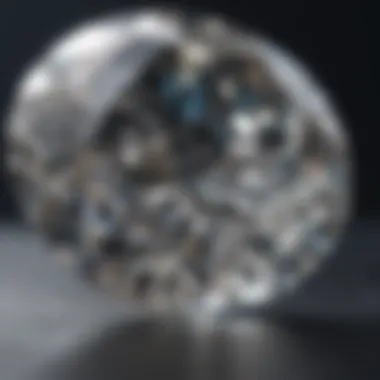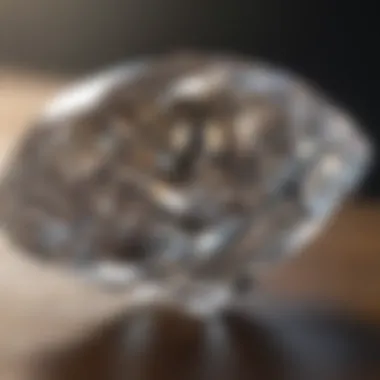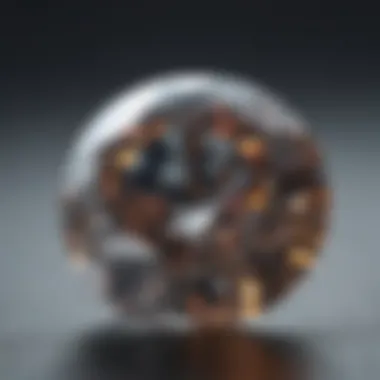Understanding Diamond Clarity: SI1 Insights Revealed


Gemstone Overview
Diamonds are among the most prized gemstones, known for their beauty, brilliance, and hardness. They form under high-pressure and high-temperature conditions deep within the Earth's mantle. Their diverse characteristics depend on factors such as mineral content, temperature, and the surrounding geological environment during formation.
Definition and Characteristics
Diamonds belong to the carbon allotrope family. They consist of carbon atoms arranged in a crystal lattice structure, which gives them outstanding hardness and optical performance.
Key characteristics of diamonds include:
- Hardness: Diamonds rate at 10 on the Mohs scale, meaning they are the hardest natural material.
- Clarity: The clarity of a diamond reflects the presence of inclusions or blemishes.
- Cut: The way a diamond is cut affects its sparkle and brilliance.
- Color: Diamonds range from colorless to shades of yellow and brown, with the rarest being blue, pink, and green.
- Carat Weight: This measures the diamond's size, with one carat equal to 200 milligrams.
Classification of Gemstones
Generally, gemstones can be organized into two categories: precious and semi-precious stones. Diamonds are classified as precious. The four Cs—cut, color, clarity, and carat—play a crucial role in determining their value. Within the realm of clarity, the SI1 grade signifies "Slightly Included 1," which indicates a specific visibility of inclusions under magnification.
Historical Significance
Diamonds have captivated humans for centuries, influencing culture and society. Their durability and beauty made them symbols of wealth and power. They often appear in cultural ceremonies, from royal engagements to powerful emblems of status.
Ancient Uses and Cultural Importance
Historically, diamonds were believed to possess magical properties. Ancient cultures regarded them as protective talismans, thought to ward off evil and ensure victory in battle. Over time, their association with love and commitment solidified through the traditions of engagement rings and wedding bands.
Myths and Legends Surrounding Gemstones
Countless myths surround diamonds. One common belief is that diamonds can bring good fortune, while another asserts their ability to provide clarity of thought. These beliefs enhance their mystique, attracting collectors and enthusiasts alike.
"The wonders of diamonds are as profound as the ideas we attach to them."
Understanding diamond clarity, especially the SI1 grade, involves looking beyond mere appearances to appreciate the significance of inclusions and how they affect value and desirability. The clarity grade can have implications for buyers regarding selection and investment.
Prologue to Diamond Clarity
Diamond clarity is an essential characteristic in the gemological evaluation of diamonds. It directly influences a diamond's value, appearance, and desirability. In this article, we will delve into the SI1 clarity grade, often mentioned in the diamond market, and explore its implications for both buyers and sellers. Understanding diamond clarity helps consumers make informed choices. It allows them to appreciate the nuances that differentiate various clarity grades and ultimately select the best diamond for their needs.
Defining Clarity in Diamonds
Clarity in diamonds refers to the presence or absence of internal flaws, known as inclusions, and external blemishes. These imperfections can affect the diamond's overall appearance and brilliance. The Gemological Institute of America (GIA) uses a specific scale to classify clarity, ranging from Flawless to Included. Inclusions vary from tiny pinpoints to larger, more visible imperfections. Evaluating clarity involves examining the diamond under magnification, where the nuances of its quality become evident.
Understanding clarity helps buyers gauge how visible these inclusions are to the naked eye, which impacts aesthetic appeal. As each inclusion is unique, a diamond’s clarity can tell a fascinating story about its formation and journey.
The Four Cs of Diamonds
The Four Cs are the foundational criteria for diamond evaluation, which include Carat, Cut, Color, and Clarity. Each aspect contributes to a diamond's overall value:
- Carat: Refers to the weight of the diamond, influencing its size.
- Cut: Describes how well the diamond has been shaped and faceted; it determines how light reflects off the surface.
- Color: Evaluates the presence of color, with colorless diamonds generally being more desirable.
- Clarity: As discussed, it addresses the presence of flaws.
Every buyer should consider these Four Cs collectively, as they help reflect the diamond's true beauty and market value. Among these, clarity is particularly scrutinized, as it can vary significantly even within diamonds that are similar in other aspects. Therefore, having a detailed understanding of clarity, especially the SI1 grade, becomes vital for making informed purchasing decisions.


The SI1 Clarity Grade Specifics
The SI1 clarity grade is an important benchmark in the world of diamonds. Understanding its specifics aids buyers in making informed decisions. "SI1" stands for "Slightly Included 1." This classification demonstrates that a diamond may contain some inclusions, but these are not easily visible to an untrained eye. Recognizing the features of SI1 diamonds is essential not only for buyers but also for sellers and appraisers. This segment elaborates on what SI1 means as well as the visual characteristics that define it.
What SI1 Means
The SI1 clarity grade indicates that a diamond has inclusions, but these inclusions are generally minor and most of the time not visible without magnification. When looking at diamonds under 10x magnification, these imperfections can be found. However, for everyday wear, SI1 diamonds typically hold a pleasing and acceptable appearance. It is important to note that clarity plays a significant role in a diamond's value, but SI1 diamonds often present an excellent combination of quality and price. Buyers should be aware that each SI1 diamond is unique, and the placement, size, and visibility of inclusions can vary widely.
Visual Characteristics of SI1 Diamonds
The visual aspects of SI1 diamonds set them apart from higher clarity grades. Here are some characteristics:
- Inclusion Visibility: At first glance, SI1 diamonds can appear very clean. Inclusions may only be noticeable under 10x magnification. The small imperfections can range from clouds to tiny crystals.
- Light Performance: SI1 diamonds still manage to reflect light beautifully. The brilliance and fire can be captivating despite minor flaws.
- Overall Aesthetic: The average observer may find it hard to discern the difference between an SI1 and a higher-grade diamond like VS1. Thus, these diamonds often appear as good choices for those wanting quality without the price of perfect clarity.
Impact of Inclusions and Blemishes
In diamonds, clarity plays a vital role in determining overall value and aesthetic appeal. The presence of inclusions and blemishes can significantly affect how a diamond is perceived, making it essential for buyers to understand these characteristics. Inclusions are internal imperfections found within the diamond that arise during its formation. Blemishes, on the other hand, are surface flaws that can occur due to handling or other factors. Both inclusions and blemishes can alter a diamond's brilliance and fire, influencing buyer decisions and market value.
Common Types of Inclusions
Inclusions come in various types, each with its unique implications for the appearance of a diamond. Some of the most prevalent types include:
- Feathers: These are hairline cracks that can extend within the diamond. While they might not always compromise structural integrity, they can affect light traversal.
- Pinpoints: These are tiny, dot-like inclusions that generally do not affect the diamond's overall clarity but can become noticeable under magnification.
- Crystals: Foreign materials within the diamond itself appear as small colored dots, often changing the visual dynamics of the stone.
- Clouds: These occur when multiple tiny inclusions cluster, creating a hazy area. Their effect can diminish the diamond's sparkle, depending on their location.
Understanding these types is crucial as they provide insights into potential weaknesses and the diamond's visual complexity.
How Inclusions Affect Appearance
Inclusions can affect a diamond's appearance in numerous ways. The extent of their impact often depends on their size, location, and number. For instance, a large inclusion located near the center might be more noticeable than multiple small inclusions scattered throughout the stone.
- Brilliance: Inclusions can disrupt light entering the diamond, impacting its brilliance and fire. This alteration might make a diamond appear less vibrant compared to a higher-clarity grade.
- Visual Perception: In ideal lighting conditions, some inclusions may be minimal or unseen to the naked eye, but they can become apparent under closer examination or different lighting.
- Value Determination: Inclusions play a significant role in the valuation of diamonds. A diamond classified as SI1 may have visible inclusions but is often priced lower than its higher-clarity counterparts, reflecting buyer preference and market demand.
Understanding inclusions is beneficial for buyers when selecting a diamond. It ensures they are informed about the potential impact on both visual beauty and future value.
"When you hold a diamond, you're not just seeing a stone—you're experiencing a history of its formation, imperfections included."
By grasping the nuances of inclusions and blemishes, buyers can make well-informed choices tailored to their preferences and budget.
Market Perceptions of SI1 Clarity
Understanding market perceptions surrounding SI1 clarity is crucial for buyers. This segment unveils how consumer expectations and trends influence the valuation of these diamonds. A diamond’s clarity impacts not only its appearance but also its market desirability. Therefore, recognizing these perceptions offers insight for prospective buyers, assisting them in making informed decisions regarding their purchases.
Consumer Sentiment on Clarity Grades
Consumer sentiment varies significantly across the spectrum of clarity grades. SI1 diamonds, which stand for "Slightly Included," possess inclusions that are generally not visible to the naked eye. Many buyers appreciate SI1 for its balance of quality and affordability. Here are some notable points regarding consumer sentiment:
- Affordability: Buyers often find SI1 diamonds more accessible compared to higher clarity grades like VS1 or VVS2.
- Value Proposition: Many consumers view SI1 as providing a good compromise between clarity and price, making it attractive in the market.
- Educational Gaps: Some potential buyers might misunderstand SI1 grades, thinking them inferior without recognizing their true characteristics.
The perception of SI1 diamonds as a smart choice reflects a broader trend towards valuing diamonds that offer beauty at a reasonable price. This sentiment has nevertheless encouraged jewelers to educate customers about clarity grades, ensuring they recognize the advantages of selecting SI1 diamonds without being swayed solely by prestige.


Trends in Pricing for SI1 Diamonds
In recent years, pricing trends for SI1 diamonds have shown notable fluctuations. Factors affecting these trends include market demand, the general economy, and buyer preferences. It is worthwhile to consider various aspects:
- Market Demand: Increased consumer interest in budget-friendly options has led to growing demand for SI1 diamonds. The inclusions in SI1 stones can often be overlooked when the diamond is set in jewelry.
- Economic Factors: Economic conditions affect jewelers' pricing strategies. During downturns, lower-priced diamonds like SI1 become more popular among buyers adjusting their budgets.
- Retail Strategies: Jewelers often promote SI1 diamonds for their affordability and beauty. Marketing efforts highlight that SI1 diamonds can be indistinguishable from higher grades in everyday settings.
Recent surveys indicate that the price-to-value perception has tilted favorably towards SI1. This shift significantly impacts overall market pricing, making it a viable option for consumers looking for high-quality diamonds without excessive expenditure.
Practical Considerations for Buyers
When looking to purchase diamonds, especially those with an SI1 clarity grade, several practical factors emerge. Understanding these considerations helps inform buyers' decisions. Price, visual appeal, and personal objectives should lead the discussion when deciding on an SI1 diamond.
Evaluating SI1 Diamonds in Person
Use of Magnification
Magnification plays a crucial role in evaluating SI1 diamonds. It allows potential buyers to closely inspect the inclusions and blemishes that define the clarity grade. The common tool for this is a jeweler’s loupe, which provides a clear view of the diamond’s internal and external features.
The key advantage of magnification is that it reveals details not visible to the naked eye, helping buyers make informed choices. You may discover that an inclusion thought to compromise beauty is actually less noticeable in natural light, thereby enhancing overall confidence in the purchase.
One aspect of using magnification is the subjectivity involved. Not all buyers will perceive inclusions the same way. Some may prioritize flawless appearance while others might value the uniqueness of imperfections. Therefore, while magnification is beneficial, it is essential to balance personal preferences with the visual assessment it provides.
Expert Assessment
Expert assessment from a certified gemologist can enhance understanding of SI1 diamonds. Professionals possess extensive knowledge about diamond grading and can clarify the implications of specific inclusions and blemishes.
The key feature of expert assessment is that it provides authoritative insights, offering buyers a reliable perspective on the quality and value of the diamonds they consider. This professional guidance can highlight areas where buyers might overlook important details.
However, hiring an expert introduces a cost factor, which can be a con for some buyers. Not all individuals may feel the need for expert validation, especially if they are confident in their assessment skills. Nonetheless, leveraging expertise can lead to a more satisfying purchasing experience, especially when navigating the SI1 category.
When SI1 Might Be a Good Choice
Budget Constraints
Many buyers operate within budget constraints, making SI1 diamonds an appealing option. These diamonds typically offer a balance of beauty and affordability compared to higher clarity grades. The key aspect of this is obtaining a visually stunning diamond without overspending.
For those on a limited budget, opting for an SI1 diamond allows engagement in quality without compromising too much on clarity. One can enjoy a well-cut diamond that sparkles and shines, while the costs remain manageable. This makes SI1 diamonds a popular choice among budget-conscious buyers who still want quality.
However, it is important to set clear expectations. Buyers should understand that the inclusions in an SI1 diamond may be noticeable under close inspection. Therefore, while they save money, they might also need to accept certain variables in appearance.
Personal Preferences
Personal preference significantly influences the decision to choose an SI1 diamond. Buyers may prioritize unique characteristics in gemstones, such as particular inclusions that resonate with them emotionally or aesthetically. The key feature here is aligning the diamond choice with individual tastes and values.
Some buyers appreciate diamonds that tell a story, while others might favor higher clarity for a specific purpose, such as an engagement ring. SI1 diamonds provide an avenue for personal expression within reasonable pricing.
That said, individual preferences can also lead to conflicting feelings about clarity. Buyers may fall for the visual allure of higher grades but feel drawn back to SI1 due to its affordability. This dichotomy means it is crucial to reflect on what one values most before making a choice.
Comparing SI1 with Other Clarity Grades


Understanding the distinctions between clarity grades is essential for anyone contemplating the purchase of a diamond. The SI1 clarity grade represents a midpoint, balancing visual appeal and cost-effectiveness. By comparing SI1 diamonds to other grades, buyers can make informed decisions that align with their preferences and budgets.
Differences Between SI1 and SI2
SI1 diamonds and SI2 diamonds have subtle but important differences. SI1 diamonds contain inclusions that are generally less detectable to the naked eye compared to SI2 diamonds. This means that an SI1 diamond often appears cleaner overall, making it an attractive option for many buyers.
- Inclusion Visibility: In SI1 diamonds, inclusions are typically challenging to spot without magnification. In contrast, SI2 diamonds have more visible inclusions that can detract from their overall appearance.
- Market Value: SI1 diamonds usually command higher prices than SI2 diamonds due to their enhanced appearance. Buyers who prioritize clarity may lean towards SI1 as it offers a better balance between value and visibility.
SI1 Versus VS1: A Closer Look
When comparing SI1 with VS1 clarity, the differences become even more pronounced. VS1 diamonds, or Very Slightly Included 1 diamonds, have inclusions that are difficult to detect even under magnification.
- Clarity Difference: The visual clarity of VS1 diamonds is superior to that of SI1. Even trained eyes may struggle to find inclusions in a VS1 diamond. This results in a stone that often shows more brilliance and fire.
- Price Discrepancy: SI1 diamonds tend to be more affordable than VS1 diamonds. For buyers on a budget, SI1 may present a satisfactory compromise, providing an appealing appearance at a lower cost.
- Target Buyer: While SI1 may attract consumers focused on budget and visual characteristics, VS1 typically appeals to those looking for top-tier quality and brilliance.
"Understanding the differences in clarity grades helps buyers find the perfect balance between beauty and value in their diamond purchase."
Misconceptions About Diamond Clarity
Understanding diamond clarity requires a nuanced perspective, especially when focusing on the SI1 grade. Misconceptions surrounding clarity can lead to misguided decisions, potentially affecting the purchasing experience as well as long-term satisfaction with the diamond. This section aims to clarify common myths that may confuse buyers and jewelers alike, emphasizing the importance of accurate information about clarity grades.
The Myth of Perfection
One prevalent belief is that diamonds must be flawless to be considered valuable or beautiful. This misconception is rooted in a misunderstanding of how clarity is graded. Flawless diamonds, while rare and exquisite, are not the only path to achieving beauty in a diamond. The SI1 grade, which stands for "Slightly Included 1," does not signify an inferior stone. Instead, it indicates the presence of minor inclusions that are often difficult or impossible for the naked eye to see.
These inclusions don't take away from a diamond's allure. Many buyers find that SI1 diamonds present a good balance between quality and affordability. They can still exhibit excellent sparkle and brilliance. The key point here is that perfection is subjective; what one person may see as an imperfection, another may appreciate as a distinctive character of the stone.
Misunderstanding the Importance of Clarity
Another common error involves overemphasizing clarity in the context of diamond quality. While clarity plays an essential role in determining a diamond's price and overall appearance, it must be viewed alongside cut, color, and carat weight—the other three Cs. For instance, even an SI1 diamond can hold a higher visual appeal than a higher clarity grade if the cut is exceptional. An ideal cut maximizes sparkles and light performance, overshadowing the minor inclusions present in the stone.
Buyers should focus on the overall appearance rather than fixating on clarity alone. Understanding this balance will lead to more informed decision-making. Consumers should also appreciate that many SI1 diamonds come with unique characteristics, and these variations can effectively contribute to a diamond's charm.
"Perfection is a myth; a diamond's allure often comes from its unique features."
To summarize, while clarity is indeed important, buying a diamond should encompass a complete view of its characteristics. This perspective helps avoid falling into the common pitfalls associated with solely focusing on clarity. Awareness and education about these misconceptions can empower buyers, enabling them to choose a diamond that fits their tastes and expectations.
Finale and Final Considerations
As we conclude our exploration of diamond clarity with a focus on SI1, it is essential to recognize the multifaceted nature of this topic. Understanding diamond clarity is not merely an exercise in grading; it serves as a vital component in the valuation of gemstones. The clarity of a diamond impacts not only its aesthetic appeal but also its market value. This section will summarize the key elements of clarity, and discuss future trends in clarity evaluations.
Summarizing the Importance of Clarity
Clarity is one of the Four Cs that determine diamond quality. It is defined by the presence of inclusions and blemishes within a diamond. SI1, which stands for "Slightly Included 1," indicates that a diamond has minor inclusions that are typically not visible to the naked eye. Understanding clarity helps buyers make informed decisions. SI1 diamonds often present an excellent compromise between quality and affordability. They enable consumers to acquire stones that retain a beautiful appearance without overspending.
The importance of clarity goes beyond the surface. Buyers often desire stones with minimal inclusions to enhance their jewelry's visual quality. For collectors and enthusiasts, clarity can be a critical aspect when assessing investment potential in diamonds. Clarity influences perceptions of quality in the market and affects how diamonds are valued.
Future Trends in Diamond Clarity Evaluations
The landscape of diamond clarity evaluations is evolving. As technology advances, methods for assessing clarity are becoming more precise. Tools like high-resolution imaging and specialized software are likely to provide buyers with clearer insights into a diamond's true condition.
Moreover, the rise of sustainability and ethical sourcing in the jewelry industry influences clarity evaluations. Consumers are increasingly interested in understanding the origins of their diamonds, leading to a more informed and conscientious approach to purchases. This trend could shift the focus from merely clarity grades to include considerations related to the ethical aspects of diamond sourcing.
In addition, a growing awareness of inclusivity and transparency in grading systems may also arise. Buyers expect detailed reports that highlight specific characteristics of diamonds, including the types and locations of inclusions. The trend is towards providing thorough documentation that enhances confidence in clarity grades.
In summary, understanding diamond clarity, particularly SI1, reveals a complex interplay between beauty, value, and ethical considerations. It is imperative for consumers and enthusiasts to stay updated on these trends and their implications for the diamond market.







